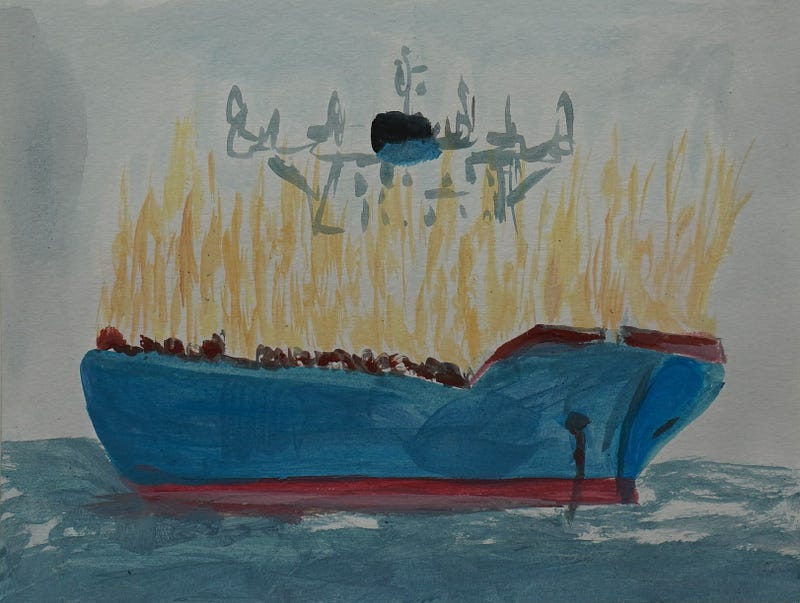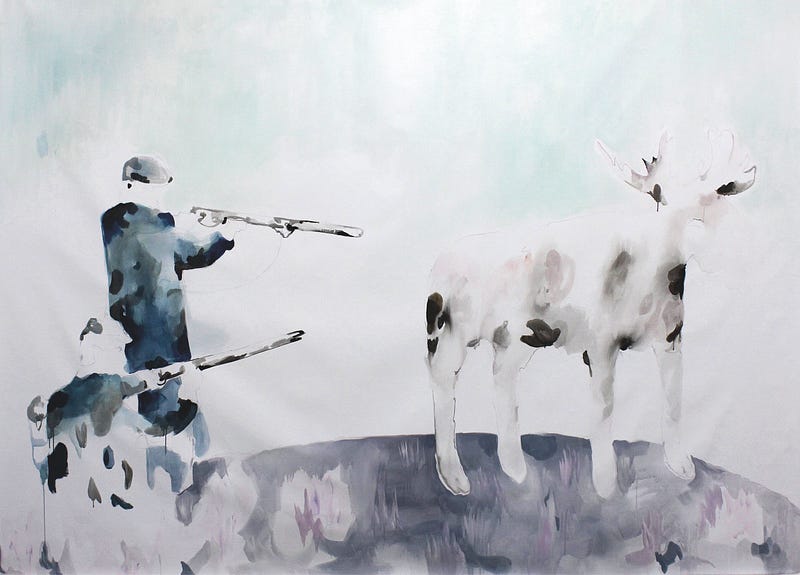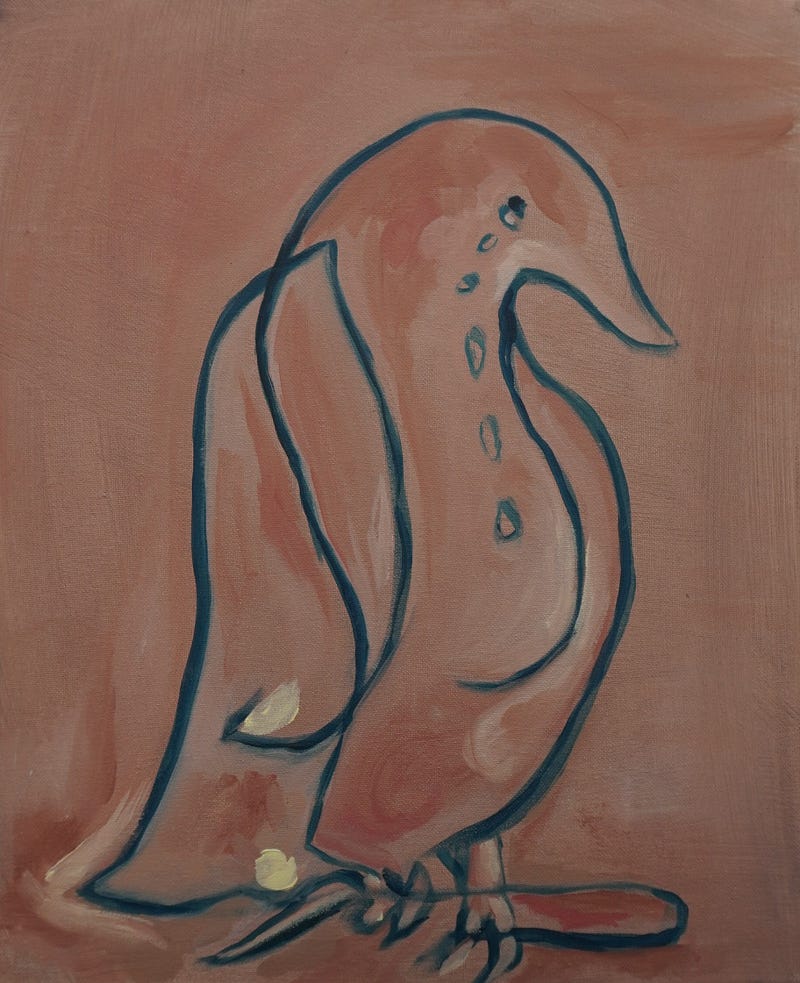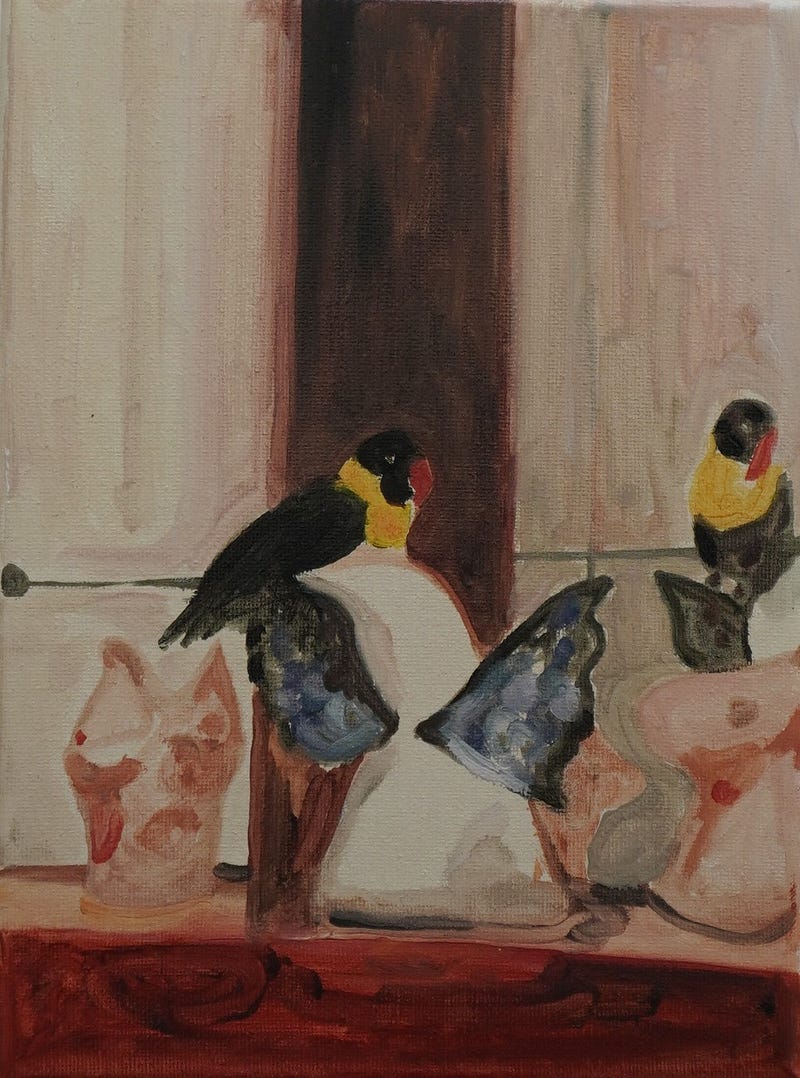12.07.2023
Nana Seferli’s liberating ecological manifesto
Visual arts
Nana Seferli’s studio is situated near the Southern suburbs of the city, and that, in Athens, means it can be found within the dense urban tissue, yet a breath away from the seacoast. In the broader region of Kallithea, the artist found a store space, bright and calm, among other small businesses and family houses. The wide street allows the sunlight to enter the room, where she paints among large canvases that brim every available surface. An enormous pink Bougainvillea tree consumes the front window and the entrance of the studio and seems to be enjoying the sun, nearly as much as does the artist, who spends most of her day there, behind that facade that resembles a vibrant summer house.
Seferli started working there after the former resident of the studio, a friend and artist, moved abroad. She explains that her working hours in the studio are more fruitful in comparison with those in her apartment, where she used to paint before. Her house, not very far from Kallithea, is already filled with paintings, material ideas, sketches, drawings and her favorite objects, while it also provides vital space for a cat, two parrots and herself. Beyond being “busy”, her private space functions more like a dynamic ecosystem of affection, comfort and safety for the artist and her loved ones. After all, she tends to establish her painting work in such holistic, non-hierarchical, organic terrenes.

However, as part of her discipline and in absolute coherence with the principles that are suffused all over her work, Seferli has recently decided to expose herself in the challenging conditions of collaborative work process. With painting as a vehicle — probably the most lonesome artistic practice — she is currently in a creative dialogue with her colleague and artist Nicolas Simantirakis, sharing the same canvas’ surface. The result is a painting series in progress of monumental compositions, where conflict and unity can be both of great value. The fact that she confronts her tendency to work in isolation, not only challenges her off path, but also liberates her. In parallel, she is part of an alluring initiative, a closed weekly sketch session of a group of women artists that is taking place on a weekly basis at Olga Vlassi’s and Anna Zissi’s studio in Neos Kosmos. There, the participants draw using as models one another, in a healing and empowering process. Seferli is grateful for both experiences, and I find her passionate way of overcoming the challenges of co-creation is exquisitely inspiring and profoundly influential to her work in terms of practice, form and content.

Since her graduation, Nana was intrigued by the power relations between human and non-human entities within ecosystems, representation in patriarchal schemes and the invention of an abolishing iconography, as a response to the above. In her degree show, under the title Simulacra (2013), scenes of hunt intertwine with emblematic authoritative figures, hunters and armed women. Among other scenes and abstract portraits, she visualized an encounter between a moose and Theodore Roosevelt. The American president was a pillar of the belief that nature exists in favor of mankind. Incarnating a patriarchal and mechanical perception of the natural world, the president is here presented hunting the same animal that he used as his own, masculine symbol during his political campaign. Until today, Seferli investigates this arbitrary attribution of meaning — even speech — to silent and precarious subjects by those in power. In 2022, she published her limited self-published edition Metazoa, where she designed the whole Greek alphabet portraying an animal for every single letter.

Seferli’s animal figures are not wild, nor tamed or enslaved. They are wise, emotional and self-actualized, but not human-like, as her painting is a reflection on an organic, autonomous and unified world. Cats, birds, dogs and plants project a realm of circulation and undisrupted flow, to which they contribute with their own special character and emotional imprint. At the same time, layers of gesso, acrylic and aquarelles form mountains, bring rivers and pulsing arteries into the third dimension. An idealized animistic utopia is very far from her inherently haunted compositions. Enigmatic animal figures, dominating vegetal organisms, scattered undefinable bodily forms evoke a sense of agony, they imply an obscure silent threat. The world as we know it, is at stake. It is not about the death of nature, it is, however, the end of the reign of structure, duality and force.

Interestingly, as I am writing these lines about Seferli’s work, an article is going viral: orca whales have been witnessed to be attacking vessels in the ocean, driven by the urge to take revenge for the loss of their babies due to interventional human activities. According to a team of scientists, it seems as though the orcas witnessed a repetitive phenomenon that activated an instinct for defense against extinction. One, of course, cannot argue with certainty that this behavior is entirely mechanical, at least I prefer to think it isn’t. I like to read this behavior as an emotional response to a collective, as well as personal threat. Seferli’s depictions of the natural world incorporate this sense of subliminal lack of safety. The viewer cannot easily choose their subject of identification: are we the endangered ones or the danger itself? The figures of cats and birds have always been used in the classical tradition to evoke feelings of affection, admiration and calmness or even as symbols of high ideas, or people of power, divinities and political personalities. In Seferli’s work, animals govern their own life, and her visual language is not appealing, cute or easy to read. It is, though, as beautiful as a flock of orcas floating in the Iberic sea, seeking for revenge.
As I am leaving the studio, I notice that the closed store next door is a former butcher’s shop. A sign on the glass window informs the business is on sale, along with the store and its equipment. I peek inside: everything is white and clean and the room is nearly of the same width as the artist’s workplace on the other side of the wall. Nothing suggests the slaughter that was once exhibited there. Nothing but the shiny, clean blade lying on the wooden cutting surface. I imagine Nana sneaking in there one night, with her parrots perched on her shoulders, using her magical paintbrush to resurrect the animals and set them free into the wild once again.
Christina Petkopoulou
Nana Seferli (b.1989) lives and works in Athens, Greece. She graduated from the Department of Fine Arts and Arts Sciences of the University of Ioannina and continued her studies with a postgraduate degree from École Européenne Supérieure d’Art de Bretagne in Quimper, France. She has presented her work at festivals and art venues in Greece and abroad. Selected group exhibitions include: Ammophila Vol.3 There Was Land Here Before (Elafonisos, 2022), Imago Mundi in Venice in 2015; PEINDRE # 2 in MICA Gallery, Rennes (France, 2014); 7> 5 in Quimper (2013); Thrills and Chills at CAN Christina Androulidaki Gallery (Athens, 2013); and Kodra Fresh 2013 Floating Walls, part of the Action Field Kodra festival held annually in Thessaloniki (Greece, 2013). Together with Lucie Ferezou, she has co-curated and participated in the duo show Under the Luna, presented in Booze Cooperativa (Athens, 2018); and with Akis Karanos in the duo show The Way the Dog Ran Away, held at Galaxias Municipal Cultural Centre in Nea Smyrni, Attica (Greece, 2016). From 2014 to 2020 she worked as an art teacher in special and general education. She has been awarded the Stavros Niarchos Foundation (SNF) Artist Fellowship by ARTWORKS (2021).
Christina Petkopoulou (Athens, 1992) is a free-lance curator, researcher and writer based in Athens. She has studied Archaeology and History of Art at the National and Kapodistrian University of Athens and the Paris I-Pantheon-Sorbonne and completed a master’s degree in Cultural Management at the Panteion University of Social Sciences. She is a member and the in-house curator of the A-DASH team, a researcher and curator of the online art projects a time of her own by Zoe Chatziyannaki and Athens Report by Anna Lascari. She has curated exhibitions and public programs (Lipiu, 2020, Playing Ground, Automatic Transmission, 2019, Liminal Aristeidis Lappas solo show, Praxitelous 33, 2016, Choro-graphies-Points of flight, Artscape Athens, 2014 and more). Her texts have been published in several editions and catalogues (The ArtNewspaper Greece, Lipiu, Vera Chotzoglou, Bona Fide, State of Concept, 2021, Ammophila II, Under the Burning Sun, 2021, The Feminine Sublime, 2019 and more). She has worked for the Greek Contemporary Art Institute (ISET) researching and documenting its archive and she has also collaborated with several cultural institutions such as the Athens Biennale (2013, 2015), Art Athina (2014, 2015) and Archaeological Dialogues (2015). In 2016, she was chosen for the Neon Foundation curatorial exchange program in collaboration with the Whitechapel Gallery and in 2019, she received the SNF Artist Fellowship by ARTWORKS. She also works as a teacher and a copy editor.



